FAS | Nuke | Guide | USA | Bomber |||| Index | Search | Join FAS
B-1B Lancer
The B-1B is a multi-role, long-range bomber, capable of flying intercontinental missions without refueling, then penetrating present and predicted sophisticated enemy defenses. It can perform a variety of missions, including that of a conventional weapons carrier for theater operations. Through 1991, the B-1 was dedicated to the nuclear deterrence role as part of the single integrated operational plan (SIOP)
The B-1B's electronic jamming equipment, infrared countermeasures, radar location and warning systems complement its low-radar cross-section and form an integrated defense system for the aircraft.
The swing-wing design and turbofan engines not only provide greater range and high speed at low levels but they also enhance the bomber's survivability. Wing sweep at the full-forward position allows a short takeoff roll and a fast base-escape profile for airfields under attack. Once airborne, the wings are positioned for maximum cruise distance or high-speed penetration. The B-1B holds several world records for speed, payload and distance. The National Aeronautic Association recognized the B-1B for completing one of the 10 most memorable record flights for 1994.
The B-1B uses radar and inertial navigation equipment enabling aircrews to globally navigate, update mission profiles and target coordinates in-flight, and precision bomb without the need for ground based navigation aids. Included in the B-1B offensive avionics are modular electronics that allow maintenance personnel to precisely identify technical difficulties and replace avionics components in a fast, efficient manner on the ground.
The aircraft's AN/ALQ 161A defensive avionics is a comprehensive electronic counter-measures package that detects and counters enemy radar threats. It also has the capability to detect and counter missiles attacking from the rear. It defends the aircraft by applying the appropriate counter-measures, such as electronic jamming or dispensing expendable chaff and flares. Similar to the offensive avionics, the defensive suite has a re-programmable design that allows in-flight changes to be made to counter new or changing threats.
The B-1B represents a major upgrade in U.S. long-range capabilities over the B-52 -- the previous mainstay of the bomber fleet. Significant advantages include:
- Low radar cross-section to make detection considerably more difficult.
- Ability to fly lower and faster while carrying a larger payload.
- Advanced electronic countermeasures to enhance survivability.
 Numerous sustainment and upgrade modifications are ongoing or under study for the B-1B aircraft. A large portion of these modifications which are designed to increase the combat capability are known as the Conventional Mission Upgrade Program. In FY93, The Air Force initiated CMUP in FY1993 to improve the B-1’s conventional warfighting capabilities. The $2.7 billion CMUP program is intended to convert the B-1B from a primarily nuclear weapons carrier to a conventional weapons carrier. Capability will be delivered in blocks attained by hardware modifications with corresponding software updates:
Numerous sustainment and upgrade modifications are ongoing or under study for the B-1B aircraft. A large portion of these modifications which are designed to increase the combat capability are known as the Conventional Mission Upgrade Program. In FY93, The Air Force initiated CMUP in FY1993 to improve the B-1’s conventional warfighting capabilities. The $2.7 billion CMUP program is intended to convert the B-1B from a primarily nuclear weapons carrier to a conventional weapons carrier. Capability will be delivered in blocks attained by hardware modifications with corresponding software updates:
- Initial conventional capability was optimized for delivery of Mk-82 non-precision 500lb gravity bombs
- Current capability (Block C) also provides delivery of up to 30 Cluster Bomb Units (CBUs) per sortie for enhanced conventional capability against advancing armor. Initial capability achieved in September 1996 with FOC in August 1997. The upgrade consists of modification for B-1B bomb module from the original configuration of 28 500-pound bombs per unit to 10 1,000-pound cluster bombs per bomb rack. The modifications apply to a total to 50 refitted bomb racks -- enough to equip half the B-1B fleet.
- Block D integrates the ALE-50 repeater decoy system, the first leg of the electronic countermeasures upgrade, and JDAM for near precision capability and adds anti-jam radios for secure communication in force packages. FY96 and FY97 Congressional plus-ups are being used to accelerate JDAM initial capability by 18 months (1QFY99). Congress has provided extra funding to allow a group of seven aircraft to be outfitted and ready a full 18 months early, with the first three JDAM equipped aircraft to be ready by December 1998, and the last of those seven aircraft are planned to arrive at Ellsworth AFB by Feb 99.
- Block E upgrades the current avionics computer suite and integrates Wind Corrected Munitions Dispenser (WCMD), Joint Standoff Weapon (JSOW) and Joint Air to Surface Standoff Missile (JASSM) for standoff capability (FY02)
- Block F improves the aircraft’s electronic countermeasures’ situational awareness and jamming capabilities in FY02
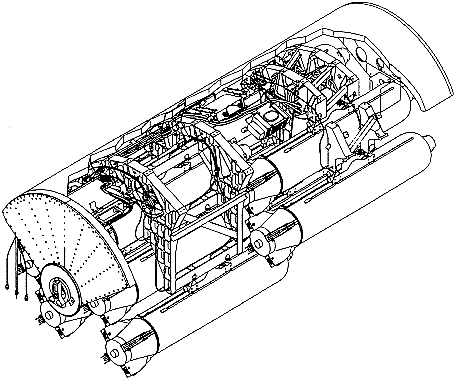
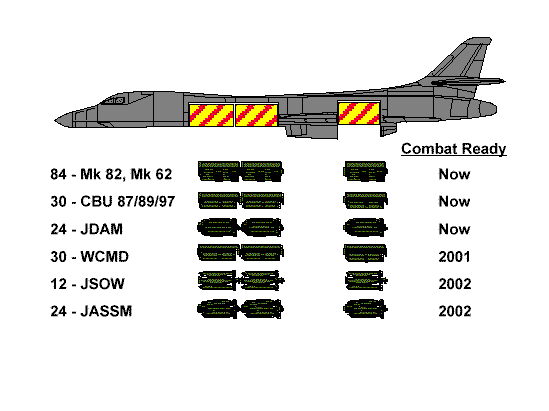

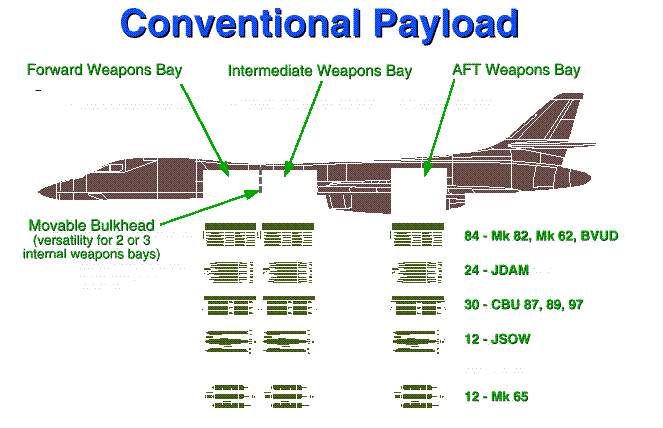
Background
The B-1B is a modified B-1A with major revisions in offensive avionics, defensive avionics, weapon payload, range, and speed. These modifications were made to incorporate certain technological advances that had occurred between the original B-lA contract award in 1970 and the LRCA competition in 1980. Improvements consist primarily of off-the-shelf technology such as a new radar, new generation computers, expanded ECM capabilities, reduced RCS, and avionics compatibility with the ALCM. The wing sweep is restricted to 60 which limits the maximum speed to just above supersonic. Rockwell also estimated range increases for the modified B-1.
Differences between the B-1B and its predecessor, the B-1A of the 1970s, are subtle, yet significant. Externally, only a simplified engine inlet, modified over-wing fairing and relocated pilot tubes are noticeable. Other less-evident changes include a window for the offensive and defensive systems officers' station and engine housing modifications that reduces radar exposure. The B-1B was structurally redesigned to increase its gross takeoff weight from 395,000 to 477,000 pounds (177,750 to 214,650 kilograms). Still, the empty weight of the B-1B is but 3 percent greater than that of the B-1A. This added takeoff weight capacity, in addition to a movable bulkhead between the forward and intermediate weapons bay, allows the B-1B to carry a wide variety of nuclear and conventional munitions. The most significant changes, however, are in the avionics, with low-radar cross-section, automatic terrain-following high-speed penetration, and precise weapons delivery.
Prior to 1994 B-1B fleet had never achieved its objective of having a 75-percent mission capable rate. In 1992 and 1993 the B-1B mission capable rate averaged about 57 percent. According to the Air Force, a primary reason for the low mission capable rate was the level of funding provided to support the B-1B logistics support system. Concerned about the low mission capable rate, a history of B-1B problems, and the Air Force's plans to spend $2.4 billion modifying the B-1B to become a conventional bomber, the Congress directed the Air Force to conduct an Operational Readiness Assessment (ORA) from June 1, 1994, through November 30, 1994. The purpose of the ORA was to determine whether one B-1B wing was capable of achieving and maintaining its planned 75-percent operational readiness rate for a period of 6 months, if provided the full complement of spare parts, maintenance equipment and manpower, and logistic support equipment. During the ORA the test unit achieved an 84.3-percent mission capable rate during the test period. The ORA demonstrated that, given a full complement of spare parts, equipment, and manpower, the Air Force could achieve and sustain a 75-percent mission capable rate for the B-1B. The Air Force projects that the entire B-1B fleet will reach a 75-percent mission capable rate by 2000 by virtue of numerous on-going and future reliability, maintainability, and management initiatives. However, as of mid-October 1999 the Air Force wide mission capable rate of the B-1 had fallen to 51.1 percent -- mainly because of maintenance problems and a shortage of parts. Over the previous 12 months, the Kansas Guard had maintained a mission capable rate of 71.1 percent for the 10 usable aircraft assigned to it.
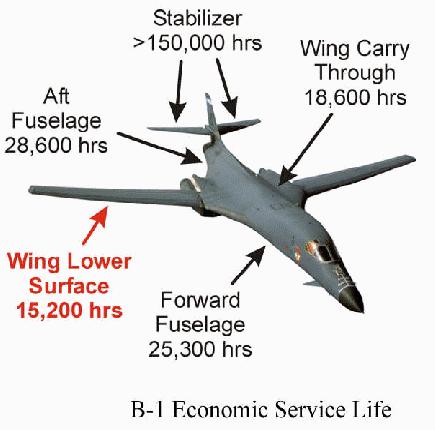 The basis for the projection of useful life of the B-1 is the Aircraft Structural Integrity Program (ASIP). The useful life of the structure is assumed to be the point at which it is more economical to replace the aircraft than to continue structural modifications and repairs necessary to perform the mission. The limiting factor for B-1’s service life is the wing lower surface. At 15,200 hours, based on continued low level usage, the wing’s lower skin will need replacement. Current usage rates, operational procedures, and mishap attrition will place the inventory below the requirement of 89 aircraft in 2018, while the service life attrition will impact around 2038.
The basis for the projection of useful life of the B-1 is the Aircraft Structural Integrity Program (ASIP). The useful life of the structure is assumed to be the point at which it is more economical to replace the aircraft than to continue structural modifications and repairs necessary to perform the mission. The limiting factor for B-1’s service life is the wing lower surface. At 15,200 hours, based on continued low level usage, the wing’s lower skin will need replacement. Current usage rates, operational procedures, and mishap attrition will place the inventory below the requirement of 89 aircraft in 2018, while the service life attrition will impact around 2038.
The first B-1B, 83-0065, The Star of Abilene, was delivered to the Air Force at Dyess Air Force Base, Texas, in June 1985, with initial operational capability on Oct. 1, 1986. The 100th and final B-1B was delivered May 2, 1988. The Air Force has chosen to fully fund the operation of only 60 B-1Bs for the next few years, compared with plans to fund 82 beyond fiscal year 2000. In the short term, the Air Force has classified 27 of 95 B-1Bs as "reconstitution aircraft." These aircraft are not funded for flying hours and lack aircrews, but they are based with B-1B units, flown on a regular basis, maintained like other B-1Bs, and modified with the rest of the fleet. B-1B units will use flying hours and aircrews that are based on 60 operational aircraft to rotate both the operational aircraft and the reconstitution aircraft through its peacetime flying schedule. These 27 aircraft will be maintained in reconstitution reserve status until the completion of smart conventional munition upgrades. At that time, around the year 2000, there will be 95 aircraft providing an operational force of 82 fully modified B-1s. The B-1 will complete its buy back of attrition reserve by the fourth quarter of FY03, and re-code six training aircraft to attain 70 combat-coded aircraft by the fourth quarter of FY04.
During the Cold War, heavy bombers were used primarily for nuclear deterrence and were operated solely by the active duty Air Force. According to the Air Force, the National Guard's part-time workforce was incompatible with the bombers' nuclear mission because of a requirement for continuously monitoring all personnel directly involved with nuclear weapons. With the end of the Cold War and increased emphasis on the bombers' conventional mission, the Air Force initiated efforts to integrate Guard and reserve units into the bomber force. As part of its total force policy, the Air Force assigned B-1B aircraft to the National Guard. Heavy bombers entered the Air Guard's inventory for the first time in 1994 with a total of 14 B-1Bs programmed by the end of fiscal year FY 1997 for two units, the 184th Bomb Wing (BW), Kansas, and the 116th BW, Georgia. The 184th completed its conversion in FY 1996 at McConnell Air Force Base (AFB), Kansas. After a long political struggle that involved resisting the planned conversion from F-15s and an associated move from Dobbins AFB near Atlanta to Robins AFB near Macon, the 116th began its conversion on 1 April 1996. The unit completed that process in December 1998. All the bombers in both units were configured for conventional, not nuclear, missions.
Prior to 1994, the B-1B fleet operated out of four bases: Dyess Air Force Base, Texas; Ellsworth Air Force Base, South Dakota; McConnell Air Force Base, Kansas; and Grand Forks Air Force Base, North Dakota. In 1994, the Air Force realigned the B-1B fleet by closing the Grand Forks Air Force Base and transferring the aircraft at McConnell Air Force Base to the Air National Guard. With the transfer, the B-1B support structure, including spare parts, was distributed to the two remaining main operating bases. The concentration of aircraft and repair facilities at Dyess and Ellsworth Air Force Bases resulted in improved support capabilities, which improved mission capable [MC] rates.
On 26 March 1996 it was announced that the 77th Bomb Squadron would return to Ellsworth. On 1 April 97, the squadron again activated at Ellsworth as the geographically separated 34th Bomb Squadron completed its transfer to its home at the 366th Wing, Mountain Home AFB, Idaho. By June 1998, the 77th had six of its B-1Bs out of the reconstitution reserve. This number ballanced those lost by the 34th BS.
Upgrades
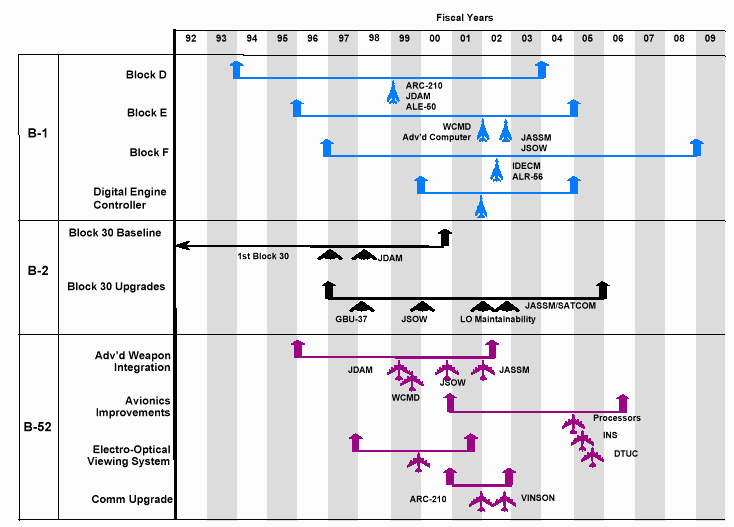
Cockpit Upgrade Program (CUP) - Current B-1 cockpit display units are not capable of supporting graphic intensive software modifications. The CUP installs a robust graphic capability via common display units throughout the front and aft stations. This program increases B-1 survivability by providing critical situational awareness displays, needed for conventional operations, keeping pace with current and future guided munitions integration, enhancing situational awareness, and improving tactical employment.
Link-16 – Providing Line-of-Sight (LOS) data for aircraft-to-aircraft, aircraft-to-C2, and aircraft-to-sensor connectivity, Link-16 is a combat force multiplier that provides U.S. and other allied military services with fully interoperable capabilities and greatly enhances tactical Command, Control, Communication, and Intelligence mission effectiveness. Link-16 provides increased survivability, develops a real-time picture of the theater battlespace, and enables the aircraft to quickly share information on short notice (target changes). In addition to a localized capability, the B-1’s datalink will include BLOS capability increasing flexibility essential to attacking time-sensitive targets.
B-1 Radar Upgrade is a candidate Long Term Upgrade that would improve the current Synthetic Aperture Radar resolution from three meters to one foot or better, allowing the B-1 to more autonomously and precisely Find, Fix, Target, Track, Engage, and Assess enemy targets with guided direct-attack or standoff munitions (JDAM/JSOW). Finally, the upgrade would replace older components that will be difficult to maintain due to obsolescence and vanishing vendors.
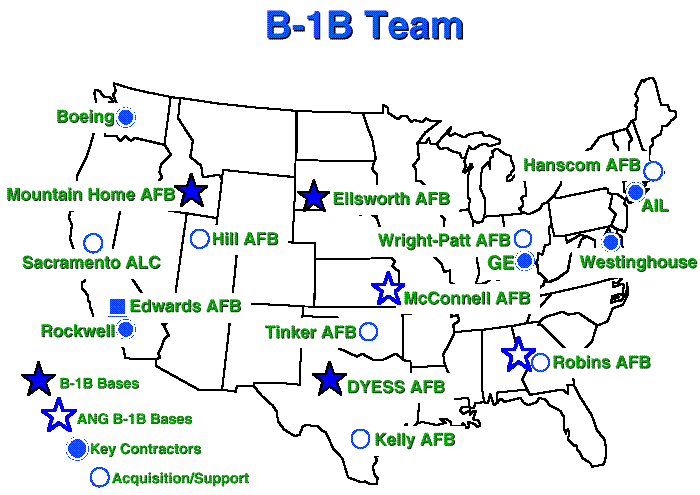
Specifications |
|||||||||||||||||||||||||||||||||||||
| Primary Function: | Long-range, multi-role, heavy bomber | ||||||||||||||||||||||||||||||||||||
| Builder: | Rockwell International, North American Aircraft | ||||||||||||||||||||||||||||||||||||
| Operations Air Frame and Integration: | Offensive avionics, Boeing Military Airplane; defensive avionics, AIL Division | ||||||||||||||||||||||||||||||||||||
| Power Plant: | Four General Electric F-101-GE-102 turbofan engine with afterburner | ||||||||||||||||||||||||||||||||||||
| Thrust: | 30,000-plus pounds (13,500-plus kilograms) with afterburner, per engine | ||||||||||||||||||||||||||||||||||||
| Length: | 146 feet (44.5 meters) | ||||||||||||||||||||||||||||||||||||
| Wingspan: | 137 feet (41.8 meters) extended forward, 79 feet (24.1 meters) swept aft | ||||||||||||||||||||||||||||||||||||
| Height: | 34 feet (10.4 meters) | ||||||||||||||||||||||||||||||||||||
| Weight: | Empty, approximately 190,000 pounds (86,183 kilograms) | ||||||||||||||||||||||||||||||||||||
| Maximum Takeoff Weight: | 477,000 pounds (214,650 kilograms)   |
||||||||||||||||||||||||||||||||||||
| Speed: | 900-plus mph (Mach 1.2 at sea level) | ||||||||||||||||||||||||||||||||||||
| Rotate and Takeoff Speeds: | 210 Gross - 119 Rotate kts / 134 kts Takeoff 390 Gross - 168 kts Rotate / 183 kts Takeoff |
||||||||||||||||||||||||||||||||||||
| Landing Speeds: | 210 Gross - 145 kts 380 Gross - 195 kts |
||||||||||||||||||||||||||||||||||||
| Range: | Intercontinental, unrefueled | ||||||||||||||||||||||||||||||||||||
| Ceiling: | Over 30,000 feet (9,000 meters)      |
||||||||||||||||||||||||||||||||||||
| Crew: | Four (aircraft commander, pilot, offensive systems officer and defensive systems officer) | ||||||||||||||||||||||||||||||||||||
| Armament: |
|
||||||||||||||||||||||||||||||||||||
| Date Deployed: | June 1985 | ||||||||||||||||||||||||||||||||||||
| Unit Cost: | $200-plus million per aircraft | ||||||||||||||||||||||||||||||||||||
| Inventory: | 100 total production 93 total current inventory Active force, 51 PMAI (69 actual) Deployment
|
||||||||||||||||||||||||||||||||||||
Airframe Inventory |
||||
| # | Tail # | Name | Location | Comment |
| 1 | ||||
| 2 | 83-0065 | Star of Abilene | Dyess | |
| 3 | 83-0066 | Ole' Puss | Dyess | |
| 4 | 83-0067 | Texas Raider | Dyess | |
| 5 | 83-0068 | Predator | Dyess | |
| 6 | 83-0069 | The Beast | Dyess | |
| 7 | 83-0070 | 7 Wishes | Dyess | |
| 8 | 83-0071 | Spitfire | Dyess | |
| 9 | 84-0049 | Edwards | ||
| 10 | 84-0050 | Dawg B-One | Dyess | |
| 11 | 84-0051 | Boss Hog | Dyess | |
| 12 | 84-0052 | Lost 09-25-87 @ La Junta, Colorado | ||
| 13 | 84-0053 | Lucky 13 | Dyess | |
| 14 | 84-0054 | Rage [Tasmanian Terror] | Dyess | |
| 15 | 84-0055 | Shockwave [Lethal Weapon] | Dyess | |
| 16 | 84-0056 | Sweet Sixteen | Dyess | |
| 17 | 84-0057 | Hellion | Dyess | |
| 18 | 84-0058 | Eternal Guardian | Dyess | |
| 19 | 85-0059 | |||
| 20 | 85-0060 | McConnell | ||
| 21 | 85-0061 | Ellsworth | ||
| 22 | 85-0062 | Uncaged | Dyess | |
| 23 | 85-0063 | Lost 11-09-88 @ Dyess AFB, Texas | ||
| 24 | 85-0064 | McConnell | ||
| 25 | 85-0065 | |||
| 26 | 85-0066 | On Defense | Ellsworth | |
| 27 | 85-0067 | |||
| 28 | 85-0068 | Edwards | ||
| 29 | 85-0069 | McConnell | ||
| 30 | 85-0070 | |||
| 31 | 85-0071 | |||
| 32 | 85-0072 | Polarized | Dyess | |
| 33 | 85-0073 | McConnell | ||
| 34 | 85-0074 | Crew Dawg | Dyess | |
| 35 | 85-0075 | Ellsworth | ||
| 36 | 85-0076 | Lost 11-17-89 @ Ellsworth AFB S.D. | ||
| 37 | 85-0077 | Ellsworth | ||
| 38 | 85-0078 | Ellsworth | ||
| 39 | 85-0079 | Ellsworth | ||
| 40 | 85-0080 | |||
| 41 | 85-0081 | |||
| 42 | 85-0082 | Global Power | Dyess | |
| 43 | 85-0083 | Ellsworth | ||
| 44 | 85-0084 | Ellsworth | ||
| 45 | 85-0085 | Ellsworth | ||
| 46 | 85-0086 | Ellsworth | ||
| 47 | 85-0087 | Ellsworth | ||
| 48 | 85-0088 | |||
| 49 | 85-0089 | |||
| 50 | 85-0090 | Ellsworth | ||
| 51 | 85-0091 | Robins | ||
| 52 | 85-0092 | Ellsworth | ||
| 53 | 86-0093 | Ellsworth | ||
| 54 | 86-0094 | Ellsworth | ||
| 56 | 86-0096 | Ellsworth | ||
| 57 | 86-0097 | Robins | ||
| 58 | 86-0098 | Ellsworth | ||
| 59 | 86-0099 | Ellsworth | ||
| 60 | 86-0100 | Phoenix | Dyess | |
| 61 | 86-0101 | Heavy Metal | Dyess | |
| 62 | 86-0102 | Ellsworth | ||
| 63 | 86-0103 | Reluctant Dragon | Dyess | |
| 64 | 86-0104 | Robins | ||
| 65 | 86-0105 | Snake Eyes | Dyess | |
| 66 | 86-0106 | Lost 12-01-92 @ IR 165, Van Horne TX | ||
| 67 | 86-0107 | |||
| 68 | 86-0108 | Alein With An Attitude | Dyess | |
| 69 | 86-0109 | Spectre | Dyess | |
| 70 | 86-0110 | Stairway to Heaven | Dyess | |
| 71 | 86-0111 | Ellsworth | ||
| 72 | 86-0112 | Black Widow | Dyess | |
| 73 | 86-0113 | Ellsworth | ||
| 74 | 86-0114 | Ellsworth | ||
| 75 | 86-0115 | |||
| 76 | 86-0116 | Robins | ||
| 77 | 86-0117 | Night Stalker | Dyess | |
| 78 | 86-0118 | Robins | ||
| 79 | 86-0119 | The Punisher | Dyess | |
| 80 | 86-0120 | Iron Horse | Dyess | |
| 81 | 86-0121 | Robins | ||
| 82 | 86-0122 | |||
| 83 | 86-0123 | [none] | ||
| 84 | 86-0124 | Dyess | ||
| 85 | 86-0125 | Robins | ||
| 86 | 86-0126 | |||
| 87 | 86-0127 | |||
| 88 | 86-0128 | Ellsworth | ||
| 89 | 86-0129 | Ellsworth | ||
| 90 | 86-0130 | Bad Company | Dyess | |
| 91 | 86-0131 | Robins | ||
| 92 | 86-0132 | Oh, Hard Luck | Dyess | |
| 93 | 86-0133 | Ellsworth | ||
| 94 | 86-0134 | Robins | ||
| 95 | 86-0135 | Deadly Intentions | Dyess | |
| 96 | 86-0136 | |||
| 97 | 86-0137 | Ace In The Hole | Dyess | |
| 98 | 86-0138 | Robins | ||
| 99 | 86-0139 | Robins | ||
| 100 | 86-0140 | Last Lancer | Dyess | |

B-1B Image Gallery
Sources and Resources
- General Accounting Office Reports
- ANNEX F Common Solution/Concept List (U) Air Force Mission Area Plan (MAP) [as of 11 July 1997 - Rev 10] - Detailed and comprehensive Air Combat Command descriptions of weapon system modernization efforts required to satisfy known needs.
- Air Force White Paper on Long-Range Bombers 01 March 1999
- B-1B Systems Program Office - Wright Patterson Air Force Base Ohio
- Conventional Mission Upgrade Program The B-1B CMUP
- B-1B FACT BOOK North American Aircraft NA 95-1210 - CHG 5 - 20 July 1995
- B-1 Bomber Offensive Avionics @ Boeing
- B-1B Aircraft Software Home Page @ Tinker Air Force Base, Oklahoma
- AN/ALQ-161A Electronic Countermeasure System
- JDAM Homepage
- B-1B Air Combat Command Factsheet
News
- Air Combat Command releases B-1B accident investigation report : Jun 12, 1998
- ACC commander defends role of B-1 : Jun 8, 1998 (AFNS) -- The B-1 can carry more bombs, go faster, and fly just as far as any other bomber, so it's going to be a workhorse, said Gen. Dick Hawley, Air Combat Command commander, during a visit here recently.
- GPS, JDAM communication upgrade kits ready for B-1B Released: May 4, 1998 (AFNS) -- A new weapon will make the B-1B Lancer more lethal and bring the Air Force weapons arsenal into the 21st Century.
- B-1B drops its first guided joint direct attack munition Released: Mar 10, 1998
- Dyess 'stands down' B-1B flying operations Released: February 20, 1998
- B-1B accident investigation report released Released: December 9, 1997
- Air Combat Command moves up safety stand down day Sep 20, 1997 (AFNS) -- At approximately 3:20 p.m. MDT on Sept. 19 a B-1B from the 28th Bomb Wing at Ellsworth Air Force Base, S.D., crashed 25 miles north of Alzada, Mont. All four crew members were killed in the crash.
- Robins team delivering on B1-B modification program 970823 -- The air logistics center is working on a modification program which allows a new cluster bomb to be dropped from the B-1B bomber.
http://www.fas.org/nuke/guide/usa/bomber/b-1b.htm
Created by John Pike
Maintained by Webmaster
Updated Wednesday, October 13, 1999 9:35:11 AM